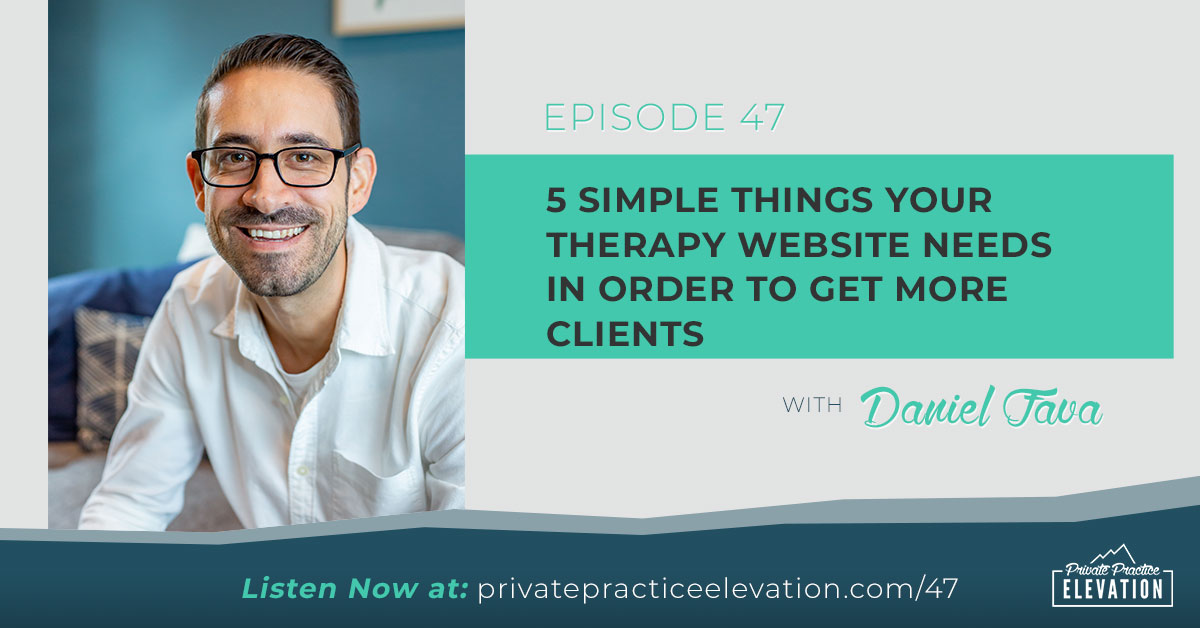Today’s episode of the Private Practice Elevation podcast is going to be right to the point.
In this episode, we’re going to talk about 5 simple things you need to have on your therapy website in order to get more clients.
Many therapists build a website and put a lot of time and effort into it, only to wonder why it’s not actually getting them any clients.
They think, “if I build it, they’ll come, right?”
Not always.
In this episode, I’ll share 5 simple things that many therapists are missing on their websites. Things that will help you get more clients in your own private practice.
In This Episode, You’ll Learn:
- Why it’s so important to have one clear call to action for your private practice website visitors
- Whether you’re confusing your potential clients on your website so much that it’s costing you their business
- One super simple element that will help you look like a professional, expert and trustworthy authority in your business
- The most important thing you need to get more traffic and ensure your ideal clients can find your website.
This Episode Is Brought To You By
Our monthly SEO content plans.
Subscribe & Review in iTunes
If you’re not yet subscribed to the podcast I want to encourage you to do that today. This is the best way to make sure you don’t miss an episode! Click here to subscribe on iTunes.
And if you’re feeling extra generous, I’d love to hear what you think about the podcast. Reviews help others find the podcast plus I’d really love to hear what you think! Click here to leave a review. Just click on “Ratings & Reviews” then “Write a review.” Let me know what you like best about the podcast. Thank you!
5 Simple Things Your Therapy Website Needs in Order To Get More Clients
1: A Clear Call To Action
A call to action is a visual element, usually a headline area with a button, that tells the website user to do something.
So many times we miss getting more potential clients to take that next step, simply because we don’t ask.
We want to make it as easy as possible for those website visitors to do what we want them to do.
Why CTAs are important
- People are distracted and you want to make it as easy as possible to take the next step.
- Some people don’t know what to do next! Remove the question.
- Users are looking for them at the end of the page to take the next step.
- They’ll help boost your conversions.
You’ll want to decide, what is the one main thing that a website user could do that would get them one step closer to being your client?
Create calls to action on each page that stand out from the rest of the text.
2: A Clear Indication of Your Services & Who They Are For
If it’s not abundantly clear on your website that you and your services can help your potential client, they may bounce off the website without even reading your content.
They show up looking for help and they decide you’re not the one because they have to dig to understand whether you can actually help them.
You can use your homepage to quickly communicate what services you offer and who they’re for.
One of the quickest ways you can grab your website viewer’s attention and get them to stay is with simple, to-the-point headers on your website pages, especially the homepage.
Example:
“Helping millennial couples and individuals create epic marriages, relationships, and lives”
You want to place these one-liners at the top of the page so visitors instantly know what the page (and you) is about.
The sentence will either resonate with the visitor and entice them to read on… or let them know they’re not a good fit for you.
It Should Contain 4 Elements:
- The Character: Who you help
- The Problem: What you help them overcome
- The Plan: Can you include HOW you help them overcome the problem?
- The Success: What does success look like?
“I help new moms cope with depression and overwhelm so they can be the mom they always dreamed they’d be.”
3: Professional Photos of yourself
This one is super simple.
Just pay for a photographer or find someone who is close to professional in some way to take some photos of you.
These types of photos scream PROFESSIONAL and they help establish a sub-conscious authority and trust via the website.
4: You Need Content
Too many times I talk with therapists who are saying things like
“My therapy website doesn’t get me clients”
Or
“My website doesn’t rank for any of my keywords so people can’t find me”
When I visit the website, I find one page that’s a bullet point list of all the topics and services they help their clients with.
No explanations, just a list.
Or if they do have a page for, let’s say Anxiety Therapy, there’s about 5 sentences on the page.
You need content in order to establish your authority and explain how you are specifically skilled to help your clients get results.
This also will help with SEO for your therapy practice.
It lets both Google AND your website visitors understand exactly what it is that you do.
For service pages – 300 – 1500 words
Over time, you want to build out web pages for every service and specialty you have in your practice.
Example: long island psychology
5: Keep Things Simple
Picture your ideal client as they search for help
Example: a person with anxiety
The goal of your website is to get the user to the information they’re looking for as quickly as possible.
The info that’s going to convince them that you are the therapist for the job.
It’s hard to get them to that info when you’ve got SO much going on on your website.
Tips:
- Don’t have multiple calls to action – don’t have a “Free Consultation” button and then this other button over here with “Download Intake Forms”
- Stick with one main call to action on the page
- If you have a lot of text, that’s ok… just make sure you break it up with headers, sub heads and various sections down the page
- Organize your menu into 5-7 links, with dropdowns to help your visitors move through the website easily


